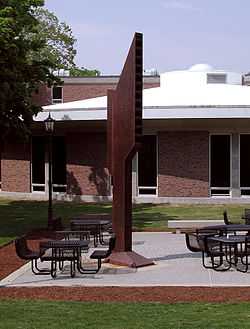John Raimondi
| John Raimondi | |
|---|---|
| Born |
May 29, 1948 Chelsea, Massachusetts |
| Nationality | American |
| Field | abstract sculptor |
| Training | Massachusetts College of Art |

John Raimondi (born May, 1948) is an American sculptor best known as a creator of monumental public sculpture, with works in more than thirty states and several European countries. He lives and works in Palm Beach Gardens, Florida
Overview
John Raimondi - creator of monuments, interpreter of life. From his early days in Winthrop, Massachusetts, Raimondi has demonstrated a unique ability to envision and create tremendous works of art that are solid in form, yet fluid in movement.
The first of four sons born to Erma and Peter Raimondi in May 1948, the sculptor spent his early years honing his skills while developing an eye for the beauty of nature that surrounded him. The young man spent much of his time in the company of his family, though he also enjoyed the solitude of drawing and painting, as well as collecting coins and building model airplanes.
In his formative years, Raimondi became fascinated by scale-model automobiles and airplanes, which later translated into full-size "hot rods" as he grew into a teenager. These hobbies proved invaluable in the artist's keen ability to comprehend scale and movement— two of the elements that are so essential in his work today.
Raimondi first ventured into the world of monumental sculpture while studying at the Massachusetts College of Art. He exhibited early works at Boston City Hall, Bridgewater State College, and numerous local galleries and museums. This led to Raimondi's first prominent commission, awarded to him in a national competition conducted by the I-80 Bicentennial Sculpture Project, in Nebraska.
This sculpture, entitled Erma's Desire, is named for the artist's mother and her intense desire for the happiness of her children. Located in Grand Island, Nebraska, the work was considered controversial, due to its suggestive title and abstract form, and was debated fiercely in several major publications and on the TV news program "60 Minutes," catapulting Raimondi into the national spotlight.
Since then, Raimondi has completed more than 100 monumental sculptures for public, corporate and private collections worldwide. He currently resides in Rockport, Massachusetts and also owns a home in Palm Beach Gardens, Florida.
Intending to become a seascape painter, Raimondi first attended the Portland School of Fine and Applied Arts in Maine. There he met teacher and sculptor Norman Therrien who encouraged Raimondi to try sculpture.[1] Next Raimondi attended the Massachusetts College of Art where he studied sculpture. Since 1970 he has been creating sculptures.[2] He currently resides in Rockport and winters in Palm Beach Gardens, Florida, where he has maintained a home since 1987.
His early works were exhibited at Boston City Hall and Bridgewater State College, along with numerous local galleries and museums. This, in turn, led to Raimondi's first prominent commission, which was awarded to him in a national competition conducted by the Nebraska I-80 Bicentennial Sculpture Project. The sculpture he created was entitled Erma's Desire.[3]
Erma's Desire is named for the artist's mother and her intense desire for the happiness of her children. Located in Grand Island, Nebraska, the work was considered controversial due to its suggestive title and abstract form, and was debated fiercely in several major publications and on the TV news program "60 Minutes", catapulting Raimondi into the national spotlight.[4] Since then, he has completed more than 100 works.
Further reading
- Corbett, William. John Raimondi, Sculptor (Hudson Hills Press, 1999) ISBN 1-55595-179-1
References
- ↑ Ask/Art website
- ↑ Harmon-Meek Gallery website this gallery in Naples, Florida first showed Raimondi's work in 1994
- ↑ Sheldon Memorial Art Gallery this site shows a photograph of the sculpture and quote from Raimondi
- ↑ John Raimondi, Sculptor Artist website
External links
- International Sculpture Center website artist page provides info on Museum collections, public collections, and exhibitions
- John Raimondi 1987 Newspaper Review discusses a sculpture entitled The Aquila, located in Miami, FL and described as "one of the largest bronze sculpture in North America".
- John Raimondi's Gallery Website A collection showcasing the various art that John Raimondi has collected over the last 40 years.
- John Raimondi's Sculpture Website Comprehensive listing of every sculpture created by John Raimondi chronologically.
|